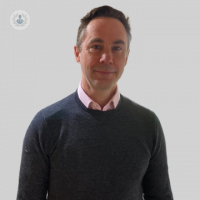Peripheral vascular disease treatment: Everything you need to know
Written by:Getting peripheral vascular disease (PVD), or peripheral arterial disease, treated can be a step towards a better quality of life where you can get back to being active. However, what's involved in PVD treatment?
Mr Patrick Lintott, leading vascular surgeon in Amersham, Oxford and High Wycombe, details everything you need to know about the treatment of PVD.

What is peripheral vascular disease (PVD) and what are the symptoms?
Peripheral vascular disease or peripheral artery disease, is where you get narrowing of the blood supply to the lower legs. Very occasionally the arms, but by in large the lower legs.
When you're sitting down, your heart pumps out about five litres of blood a minute, and of that, 500 millilitres, or a pint in imperial, goes to your legs. Because they're just sitting there not doing anything, they don't even need that much. They can get by on a lot less than that. However, as soon as you start walking, your legs need a lot more blood. That's why your heart rate goes up and you pump more out.
If you're walking briskly, then you're probably pumping out about 10 metres a minute. Of those 10 litres, the majority of those extra five litres that you're pumping out is going to your legs, so two and a half to three litres a minute going to each leg. Your leg uses this in its muscles, to power the muscles. It's like fuel in the car.
Because we are designed to be able to run really fast when we're young, and when we're chasing buses and so on, we're engineered as such that we can pump up to 20 litres in your twenties out of your heart a minute, and pump out eight to 10 litres into each leg. The size of your blood vessels that go to your legs are really quite big. They're like storm drains designed for these emergency moments where you have to run away from a woolly mammoth.
However, the vast majority of the time, we never use that and the older we get, the less we use it. In fact, you can slowly, as the amount you walk decreases with time, you can actually narrow your arteries quite significantly and you wouldn't notice because you never run for a bus; partly because you don't want to, and partly because your joints won't let you. As we age, we need our arteries to be smaller in size because we're not all running marathons in our eighties anymore.
That's the basics of it. You've got a blood supply; a big vessel that's taking blood to your muscle. That artery can age and narrow, or fur up, for want of a better term. That process starts when we're about 15 to 18 in everybody. That's just the way it is.
As we get older, depending on genetic and environmental factors, the biggest of which is diabetes and smoking, we can speed up that process or we can slow it down. So, if you have a fit individual at the age of 60 who has never smoked and isn't diabetic, who exercises regularly, then the chances of having significant peripheral vascular disease at the age of 60 is extremely small. Whilst, if they're a smoker and have been diabetic for more than 10 years, then their chances are about 50 times higher of having significantly hardened arteries to the legs.
Symptoms of peripheral vascular disease
What symptoms you get, depends on what you do with your legs. So, if you don't walk very much, you might never notice. You can narrow your blood vessels by over half and you mightn't be able to run but you'll still be able to walk.
The first symptom of peripheral artery disease is when you want to walk further than your blood supply will let you. This may be, that if you're a fit runner, or do a lot of walking, this is when you'll probably notice earlier if your someone with arthritis or someone who doesn't do much exercise. So, the amount of disease is dependent on the amount of activity.
Claudication
The big symptom is what we call claudication, and that's like a cramp-like sensation in the muscle saying it's not getting enough oxygen from the blood stream. It typically feels like a tightening in the calves - this is the most common place because the calves the biggest muscle when you're walking. It makes most of the effort when you're walking. It tightens up after you've been walking for a while. A good average is, say, two to 400 yards. You're fine setting off and then it starts to tighten a little bit, and as you continue to walk the calf slowly runs out of muscle, tightens and tightens, and then it seizes up and you physically can't walk anymore because it's run out of oxygen. You wait for a few minutes, the oxygen replenishes itself as the needs of the muscle have gone down, and then you can walk again. You can walk further, say 100, 200 yards and then the same thing will happen again. You'll stop and so the cycle repeats. It's relatively predictable.
Most patients with claudication will know how far they can walk before it starts. It will vary a little bit from day-to-day, and it will also vary on hills. It's worse when you're going up hills, worse if you're carrying, worse if you happen to be anaemic for some reason, worse if you have a chest infection and you aren't getting as much oxygen into your blood. And so forth. That’s the main symptom of PVD.
It's a bit like angina. Angina is the heart muscle getting pain because it isn't getting enough oxygen because the arteries of the heart are clogged up. It's exactly the same thing, but in the legs. The biggest difference is that the heart isn't allowed to stop. So, the heart can't take a rest. When you get angina, you absolutely have to stop exercising, slow down, reduce the demand on your heart and let it recover. Whilst with your legs, you can push it until you can't physically walk any farther, and actually that will help the body to push more blood into the muscles. They can recover over the next couple of hours when they're not having to do anything, and the cycle can repeat. That's the main symptom of PVD; claudication.
What's the most common treatment of PVD?
The most common treatment of PVD, initially, is just walking. If you ask me to run five kilometres, I suppose I could do it. If you ask me to run a marathon, I don't think I could today. If you incentivise me enough, I'm sure I could do it next year. It's a matter of running 'til it hurts, then running a little bit further, then taking a couple of days off and the next day doing the same thing until eventually you build up and build up. My blood supply doesn't change. What happens is that my muscles get used to doing more with less; they adapt.
The same thing happens with people that have PVD but at a lower level. If they can only walk 200 yards, frequently you find with patients they've had a period where they've been inactive, they've been ill for certain reason or maybe the lockdown has stopped them walking, and their general fitness has dropped. Then they set off walking, and suddenly they find they can't walk as far as they're used to and they think 'gosh, what's going on?'. In fact, what they're doing is revealing the underlying PVD they've had for years but just never noticed because they've been fit enough to walk through it.
If we can get them to push it a bit and get themselves back to their previous level, then actually all they need to do is walk on a regular basis, as far as they can and a little bit further. That's the single best thing for managing PVD. Then, obviously, you want to try and stop making it worse so you look at the risk factors, which is blood pressure control, managing cholesterol, managing diabetes, and of course trying to stop smoking if that's an issue.
What are other treatment options?
As in the heart, where you can do balloon angioplasties, stents and bypasses, you can do exactly the same in the leg arteries. Depending on symptoms and depending on the ability to respond to exercise, and of course what the ambitions of the patients are, and their general fitness. So, it also depends a little bit of the size of the arteries, and which part of the leg the arteries are affected in.
Angioplasty
Angioplasty, where you put a wire across the narrowing of an artery to blow a balloon up to stretch that artery, then possibly leave a stent behind which is a metal cage that you leave in the artery afterwards to stop it collapsing back down again once you've stretched it up. You don't always have to, but you can do. That's a fairly standard treatment for PVD depending on the level of symptoms, and the level of need of the patient. Some patients, if you've got a 55-year-old postman who needs to keep his job, but he's only able to walk 200 yards meaning he can't do his job then quite clearly, you'd want to do something to help him. Whilst if you had someone in their eighties who was able to walk 100 yards but actually didn't really need to walk any more than that on a regular basis, because their arthritis in their knees and hips limit them then you wouldn't necessarily need to. So, it's a balance.
Treatment with angioplasties and stents are relatively common. It isn't a cure. The smaller the artery you treat, the shorter period of time these angioplasties and/or stents, tend to last, but you can, in larger arteries, you can get good results with stents lasting 10 years or more. With smaller arteries, perhaps a couple of years. It varies little bit. It's no replacement for exercise but it's a good augment in the correct patients who have the simple claudication-style pain, and not the more sever end of the disease.
Long block
Then, of course, if it's a long block, usually in a leg artery or perhaps in artery, slightly higher up, that feeds the leg from inside the abdomen, then you can do bypasses. Which is actually a surgical operation; you have to make a cut, find the artery and then put a bypass converting a spare vein a patient may have, or a piece of plastic tubing to take blood around the blocked artery to an area that's open around the blockage.
They tend to last longer than angioplasties and stents, but obviously it's a bigger commitment for the patient to go through a bypass, than it is to have an angioplasty. It's about having a good relationship with the patient and to try and understand what their needs and expectations are, as well as for them to know what risk they're taking.

Has there been a recent breakthrough in PVD treatment, or is there anything currently being tested?
There are advances being made all the time. From an angioplasty and stenting point of view, probably the most interesting thing recently is shockwave treatment. This is where you've got a very hard, calcified narrowing where the body has actually tried to turn the narrowing into bone. That doesn't respond very well to a balloon.
However, there's narrow shockwave treatment where you can put in a little ultrasound shockwave wire that will help to break that hardened artery up before the balloon, and give you better results. We're having some interesting results with shockwave treatments in some segments, where previously we would have thought the only way to do it is with surgery.
From a surgical point of view, probably the most interesting advance is that over the last couple of years we've found a new type of bypass material. Previously, we've had to use the patient’s own vein, which would be non-varicose; you can't use a varicose vein. You can use a non-varicose great venous vein, it's a spare vein in the leg that you can take out and turn it around, and take the valves out and use that a bypass conduit. That's really very good.
If patients have a vein that's too small, or too large, or has been taken out for disease processes, and they don't actually have a vein to use, then previously you had to use a prosthetic like PTFE or Dacron, which are man-made materials. More recently, we've now got what we'd call bovine material which is a biological bypass that is artificially created. These seem to give some of the advantages of the PTFE, which is just on the shelf and you don't have to make cuts to take it out of the patient first. It also has the advantages of the vein, and that it resists infection. That's the most recent advance in bypasses that we've taken on over the last year.
Can PVD be cured?
If there's an isolated area, so, you just have one artery that's hardened, and you core that artery out surgically and take away the hardened area and sew the artery up again, you're effectively setting up the patient back to where they were before. However, that is phenomenally rare.
The vast majority of patients, they're getting narrowing in their arteries all over the place and what you're trying to do is treat the worse areas, and manage the patient. We're all getting older, and if someone works out how to stop it can you tell me? That would be nice. We're all getting older, and what we're trying to do is stay as active as we can for as long as we can whilst not upsetting the apple cart and not taking too many risks. It's a careful balance that you have to think about. So, I think curing PVD is impossible any more than we can stop ourselves getting older. It's about trying to manage the condition.
If you'd like to arrange an appointment with Mr Lintott, you can do so via his Top Doctors profile.


